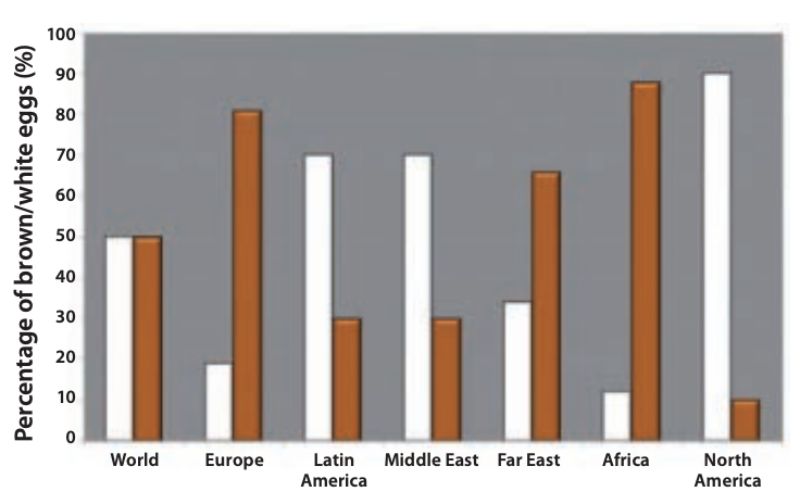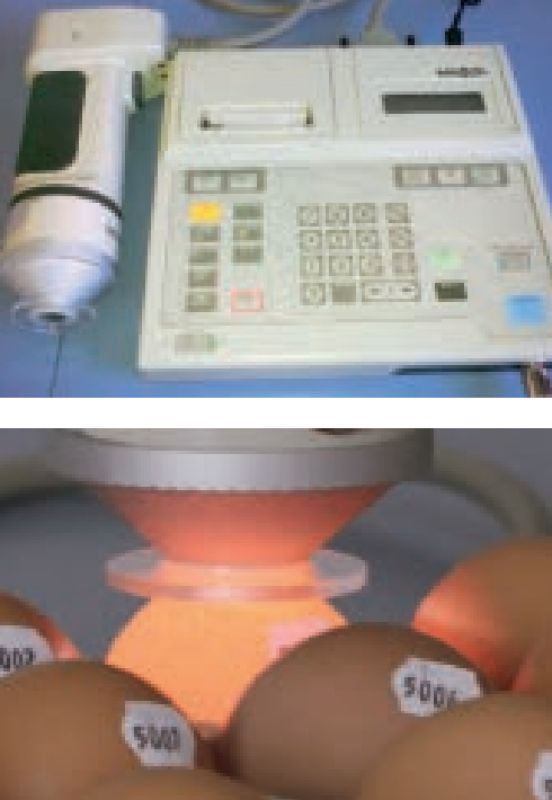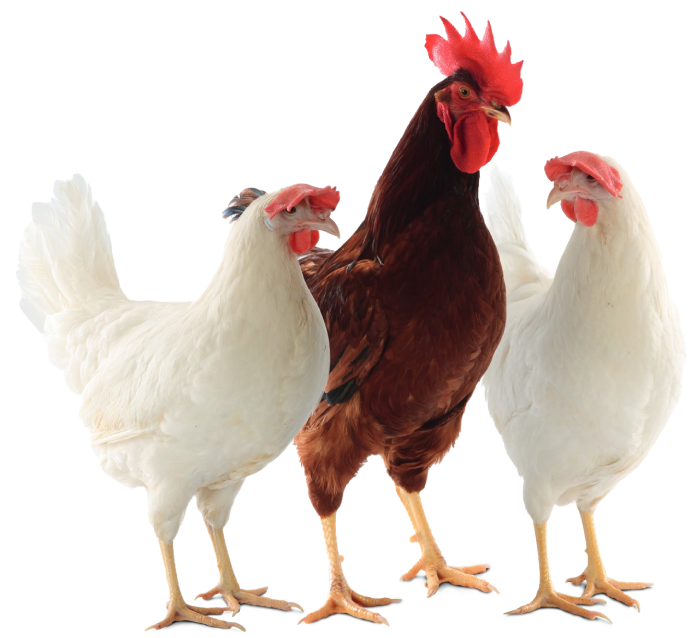First quality eggs must have first quality shells, i.e. they must be clean and have
strong shells to withstand handling and transportation. In addition to these primary shell quality criteria and adequate egg weight, a uniform and attractive
white or brown shell colour is very important to the consumer.
The consumer assesses the quality of an egg according to his specific subjective demands, and one of these demands is clearly eggshell colour. The proportion of white and brown eggs consumed in the world is roughly 50:50 with significant differences between continents in preferred shell colour (Figure 1).
Figure 1: Estimated percentage of brown and white eggs worldwide.
Shell colour is not an indication of internal egg quality and says nothing about the nutritive value or the quality of the egg. However, many consumers who prefer brown eggs, also pay attention to the intensity and uniformity of colour. Pale or unevenly coloured eggs may be rejected. Clearly, reduced variability of eggshell colour improves the presentation of eggs at the point of sale.
Colour determination with the L*a*b* colour system
The colour of an object is determined by pigments. These are chemicals which create a given colour by subtracting parts of the spectrum of the incident light. The remaining light is reflected and this gives the object its colour. Colour is a matter of perception and subjective interpretation of the person looking at the object. When colours are classified, they can be expressed in terms of their lightness (brightness), hue (colour) and saturation (vividness). Using the Minolta device (Reflectometer CR 300, figure 2), the colour of each individual egg can be objectively determined by the following three parameters:
• L*: lightness (value between 0 = black and 100 = white) • a*: hue as a function of the red-green scale (<0 >0 = red) • b*: hue as a function of the blue-yellow scale (<0 >0 = yellow

Figure 2: Reflectometer used to measure eggshell colour
To speed up selection for dark shell colour, LOHMANN TIERZUCHT started measuring eggshell colour in large numbers of pedigreed brown-egg layers with the Minolta reflectometer in the early 1990s. While subjective scores depend on light sources in the observation room and preferences of individual graders, the objective parameters are measured on a continuous scale and can be compared across locations and years and between different ages of the same flock. More important from a breeder’s point of view is that the variation within a pedigreed flock can be analysed as a normally distributed quantitative trait and used for systematic selection in the direction of consumer preferences.
Eggshell colour as a breeding goal
Commercial brown-egg lines have been selected for attractive dark brown shells for many years, based on subjective evaluation and quantitative measurement of shell colour. Moderate values of heritability for eggshell colour indicate considerable variation in shell colour among families and individual hens within a line. Since the breeding goal is to select for dark brown eggshells. Individuals with a breeding value for sub-standard shell colour are unlikely to be selected – unless they are outstanding in most of the other traits. The overall breeding goal is focused on a high number of “saleable” eggs, i.e. to be selected, a candidate must have positive breeding values for both egg number and egg quality, while more eggs with undesirable shell quality are least desired.
E ects of hen age on the eggshell colour
It has been reported that older hens tend to lay larger eggs with lighter shell colour. This is because the quantity of pigments deposited on the shell surface does not increase in relation to the egg size. Hence, the pigments of brown eggshells are deposited over a larger surface area as the hen ages and lays larger eggs. Results of LOHMANN TIERZUCHT pure line layers showed for a Rhode Island Red line that the eggshells became significantly lighter with increasing age, whereas a tested White Rock line still had an excellent shell colour at 60 weeks of age. The heritability estimates of all colour parameters were similar at different ages. Close genetic correlations between measurements at the different ages suggest that hens which lay eggs with a dark shell colour at peak production, will also tend to lay dark coloured eggs at the end of the cycle, indicating the strong genetic component for general shell pigmentation. If additional measurements at the end of the laying period add little to the accuracy of breed ing value estimation, measuring eggshell colour at an intermediate age should be sufficient to monitor and further improve lifetime eggshell colour.
New ideas to describe and improve “attractiveness” of eggshell colour
Some eggs look more attractive than others because they have a natural “shine” as if they were washed and oiled. This phenomenon can be observed in both white and brown eggs with different frequency. In Europe and other countries where washing and oiling of eggs is not permitted, it would be interesting to know whether the shine of the eggs is a heritable trait which could be used to improve the attractiveness of shell eggs at the time of purchase.
We have tested a new device (Spectrophotometer Minolta CM 600d) along with routine measurements of eggshell colour parameters (L*a*b*). Data for the shininess of eggshells were collected for two brownegg pure lines to estimate genetic parameters for this new characteristic. Shininess is measured by comparing the reflection from different angles. An eggshell with a value of 0 has no shine and is completely matt, and the higher the measured value, the shinier is the eggshell. In this study, the shininess of the eggs varied between 0 and 14, with an average of 2.6. The shininess was lower in the Rhode Island Red line as compared to the White Rock line. This trait had a moderate heritability and desirable genetic correlations with all three colour parameters which therefore determines shininess as a useful selection tool.
Perhaps even more interesting than aesthetic considerations would be to find a positive relation between the shininess of the eggshell and increased protection against pathogen penetration. It seems reasonable to expect that eggs exhibiting a brilliant shine are more likely to have an intact cuticle than eggs with a matt appearance. However, preliminary studies with special equipment have not confirmed the assumption that the shine on eggs also reflects an intact cuticula, which would be highly desirable in the context of food safety.
Conclusion
Improving eggshell quality is a significant objective for breeders to satisfy consumer preferences. The heritability of shell colour is moderately high which allows the breeding companies to achieve further genetic improvement in commercial layers. Shell colour in brown eggs tends to deteriorate toward the end of the laying cycle, but a close genetic correlation at different ages assures that early measurements will also improve life time shell colour. While eggshell quality is receiving a lot of attention in genetic selection programmes, egg producers should be aware of all non-genetic factors which must be controlled to satisfy high customer expectations in oversupplied markets. In addition to high quality feed and water effective control of diseases and air quality, monitoring the functioning of all equipment and special attention must be paid to frequent egg collection and egg storage under optimal conditions.
Dr. David Cavero and Dr. Wiebke Icken
The consumer assesses the quality of an egg according to his specific subjective demands, and one of these demands is clearly eggshell colour. The proportion of white and brown eggs consumed in the world is roughly 50:50 with significant differences between continents in preferred shell colour (Figure 1).

Figure 1: Estimated percentage of brown and white eggs worldwide.
Shell colour is not an indication of internal egg quality and says nothing about the nutritive value or the quality of the egg. However, many consumers who prefer brown eggs, also pay attention to the intensity and uniformity of colour. Pale or unevenly coloured eggs may be rejected. Clearly, reduced variability of eggshell colour improves the presentation of eggs at the point of sale.
Colour determination with the L*a*b* colour system
The colour of an object is determined by pigments. These are chemicals which create a given colour by subtracting parts of the spectrum of the incident light. The remaining light is reflected and this gives the object its colour. Colour is a matter of perception and subjective interpretation of the person looking at the object. When colours are classified, they can be expressed in terms of their lightness (brightness), hue (colour) and saturation (vividness). Using the Minolta device (Reflectometer CR 300, figure 2), the colour of each individual egg can be objectively determined by the following three parameters:
• L*: lightness (value between 0 = black and 100 = white) • a*: hue as a function of the red-green scale (<0 >0 = red) • b*: hue as a function of the blue-yellow scale (<0 >0 = yellow

Figure 2: Reflectometer used to measure eggshell colour
To speed up selection for dark shell colour, LOHMANN TIERZUCHT started measuring eggshell colour in large numbers of pedigreed brown-egg layers with the Minolta reflectometer in the early 1990s. While subjective scores depend on light sources in the observation room and preferences of individual graders, the objective parameters are measured on a continuous scale and can be compared across locations and years and between different ages of the same flock. More important from a breeder’s point of view is that the variation within a pedigreed flock can be analysed as a normally distributed quantitative trait and used for systematic selection in the direction of consumer preferences.
Eggshell colour as a breeding goal
Commercial brown-egg lines have been selected for attractive dark brown shells for many years, based on subjective evaluation and quantitative measurement of shell colour. Moderate values of heritability for eggshell colour indicate considerable variation in shell colour among families and individual hens within a line. Since the breeding goal is to select for dark brown eggshells. Individuals with a breeding value for sub-standard shell colour are unlikely to be selected – unless they are outstanding in most of the other traits. The overall breeding goal is focused on a high number of “saleable” eggs, i.e. to be selected, a candidate must have positive breeding values for both egg number and egg quality, while more eggs with undesirable shell quality are least desired.
E ects of hen age on the eggshell colour
It has been reported that older hens tend to lay larger eggs with lighter shell colour. This is because the quantity of pigments deposited on the shell surface does not increase in relation to the egg size. Hence, the pigments of brown eggshells are deposited over a larger surface area as the hen ages and lays larger eggs. Results of LOHMANN TIERZUCHT pure line layers showed for a Rhode Island Red line that the eggshells became significantly lighter with increasing age, whereas a tested White Rock line still had an excellent shell colour at 60 weeks of age. The heritability estimates of all colour parameters were similar at different ages. Close genetic correlations between measurements at the different ages suggest that hens which lay eggs with a dark shell colour at peak production, will also tend to lay dark coloured eggs at the end of the cycle, indicating the strong genetic component for general shell pigmentation. If additional measurements at the end of the laying period add little to the accuracy of breed ing value estimation, measuring eggshell colour at an intermediate age should be sufficient to monitor and further improve lifetime eggshell colour.
New ideas to describe and improve “attractiveness” of eggshell colour
Some eggs look more attractive than others because they have a natural “shine” as if they were washed and oiled. This phenomenon can be observed in both white and brown eggs with different frequency. In Europe and other countries where washing and oiling of eggs is not permitted, it would be interesting to know whether the shine of the eggs is a heritable trait which could be used to improve the attractiveness of shell eggs at the time of purchase.
We have tested a new device (Spectrophotometer Minolta CM 600d) along with routine measurements of eggshell colour parameters (L*a*b*). Data for the shininess of eggshells were collected for two brownegg pure lines to estimate genetic parameters for this new characteristic. Shininess is measured by comparing the reflection from different angles. An eggshell with a value of 0 has no shine and is completely matt, and the higher the measured value, the shinier is the eggshell. In this study, the shininess of the eggs varied between 0 and 14, with an average of 2.6. The shininess was lower in the Rhode Island Red line as compared to the White Rock line. This trait had a moderate heritability and desirable genetic correlations with all three colour parameters which therefore determines shininess as a useful selection tool.
Perhaps even more interesting than aesthetic considerations would be to find a positive relation between the shininess of the eggshell and increased protection against pathogen penetration. It seems reasonable to expect that eggs exhibiting a brilliant shine are more likely to have an intact cuticle than eggs with a matt appearance. However, preliminary studies with special equipment have not confirmed the assumption that the shine on eggs also reflects an intact cuticula, which would be highly desirable in the context of food safety.
Conclusion
Improving eggshell quality is a significant objective for breeders to satisfy consumer preferences. The heritability of shell colour is moderately high which allows the breeding companies to achieve further genetic improvement in commercial layers. Shell colour in brown eggs tends to deteriorate toward the end of the laying cycle, but a close genetic correlation at different ages assures that early measurements will also improve life time shell colour. While eggshell quality is receiving a lot of attention in genetic selection programmes, egg producers should be aware of all non-genetic factors which must be controlled to satisfy high customer expectations in oversupplied markets. In addition to high quality feed and water effective control of diseases and air quality, monitoring the functioning of all equipment and special attention must be paid to frequent egg collection and egg storage under optimal conditions.
Dr. David Cavero and Dr. Wiebke Icken






